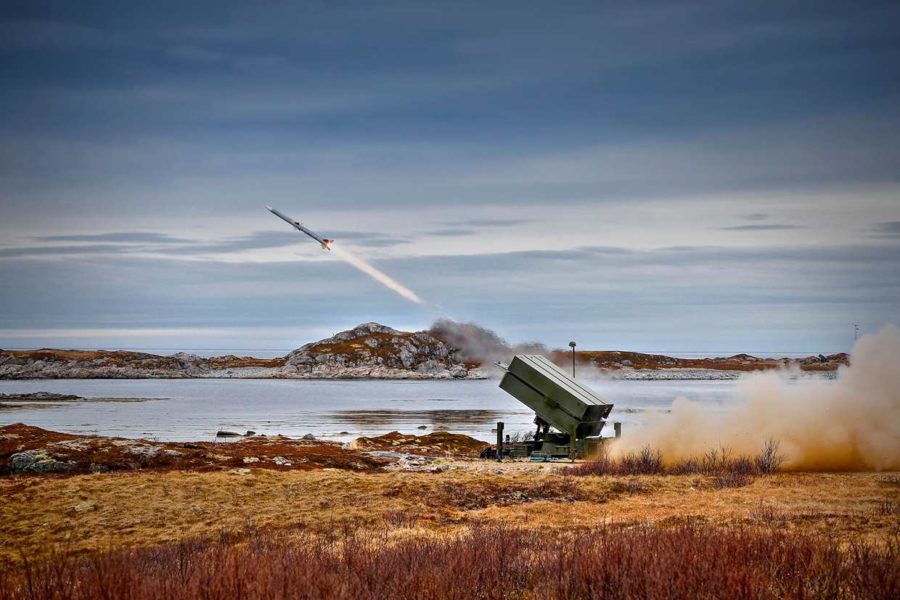The Pentagon announced an $820 million aid package to Ukraine that includes the same advanced Norwegian air defense system used to protect the White House. Coupling that with recently arrived multiple-launch rocket systems, the Defense Department said it expects rapid battlefield gains in the Donbas region.
The aid package announced July 1 was previewed by President Joe Biden a day earlier before departing the NATO leaders’ summit in Madrid. A DOD news release confirms the details of the package, which amounts to $770 million in U.S. purchases for Ukraine that include two Norwegian-made National Advanced Surface-to-Air Missile Systems (NASAMS) for air defense; 150,000 additional rounds of 155 mm artillery ammunition; and four additional counter-artillery radars.
An additional $50 million in the package for Ukraine consists of the 14th presidential drawdown, or transfer of U.S. stocks to Ukraine, consisting of additional ammunition for high-precision High Mobility Artillery Rocket Systems (HIMARS) that have begun delivery to Ukraine.
“This is something that we have been asking for,” Yuriy Sak, adviser to the minister of defense of Ukraine, told Air Force Magazine by phone from western Ukraine just prior to the official announcement.
“That’s very good for us,” he added. “These are modern, NATO standard systems which are capable of protecting the Ukrainian sky from these missile strikes.”
Sak said the NASAMS are better equipped, have a longer range, and are higher-precision than the systems Ukraine currently has in its inventory, which include Soviet-era S-300 missile defense systems donated by Slovakia in April.
A Norwegian defense official told Air Force Magazine the Norwegian-developed system has a “pretty good range” and will help defend critical infrastructure and military assets alike. The range of the system will depend on the effectors, or missiles, used.
“This is an air defense system that will be longer-range and will be an added asset for the protection of the courageous and brave Ukrainian military units and population,” the official said.
In recent days, Ukraine has suffered cruise missile strikes on civilian targets by Soviet-era Russian X-22 anti-ship missiles.
“These are not high-precision weapons,” Sak said. “The kinds of missiles that were used by these war criminals to strike the Kremenchuk shopping mall as well as the Odesa recreation place today in the morning.”
Sak expected the NASAMS to immediately make Ukrainian citizens feel more secure.
“This is going to prevent Russia from employing these terror tactics that [are] trying to terrify the peaceful citizens of different Ukrainian cities,” he said.
The Norwegian defense official expressed high confidence in the capabilities of the defensive system, which has been used to protect Washington, D.C., since 2005.
“It basically takes out what’s coming at you,” the official said. “It’s a reactive system as well, and there are opportunities to integrate with other systems as well so you can have a more coherent air defense.”
A senior defense official who briefed Pentagon journalists following the announcement also described the offensive success Ukraine has enjoyed from recent delivery of High Mobility Artillery Rocket System (HIMARS), which have allowed Ukraine to target Russian command and control, and Guided Multiple Launch Rocket Systems (GMLRS).
“Ukrainians are actually systematically selecting targets and then accurately hitting them, thus providing this precise method of degrading Russian capability,” the official said.
Despite the Russian consolidation of its gains in the eastern Donbas region of the country, the official described Russia’s progress as “halting” on the battlefield and said the combination of the defensive system and the new offensive weapons can reverse battlefield gains for Russia.
The Ukrainian defense official said that once the new systems arrive, they can also help protect Ukrainian forces on the front line.
“These systems are used to create a shield for Ukrainian armed forces who are trying to liberate Ukrainian temporarily occupied lands in the south region,” said Sak.
With the HIMARS, the senior U.S. defense official said Ukraine can continue to degrade Russia’s operational capabilities.
“We’re seeing them having a good deal of success in employing these HIMARS to include things like targeting command posts,” the official said. “This is a capability that enables Ukrainians to be able to target the Russian targets that they need to.”
